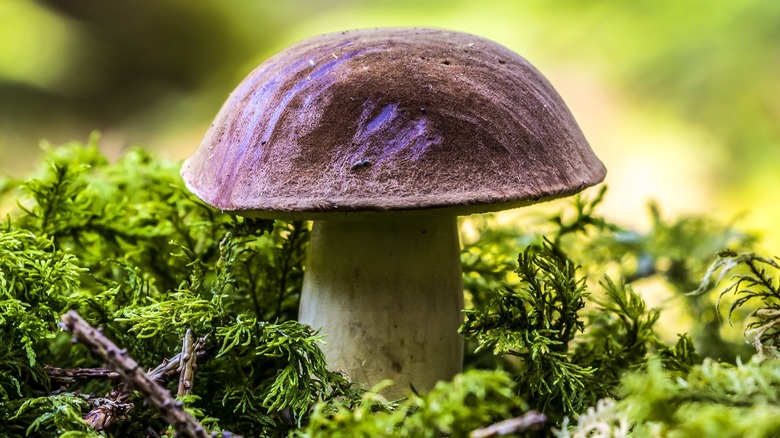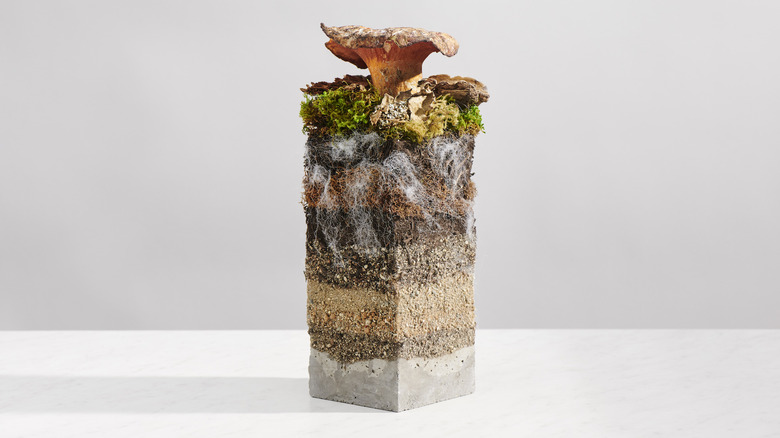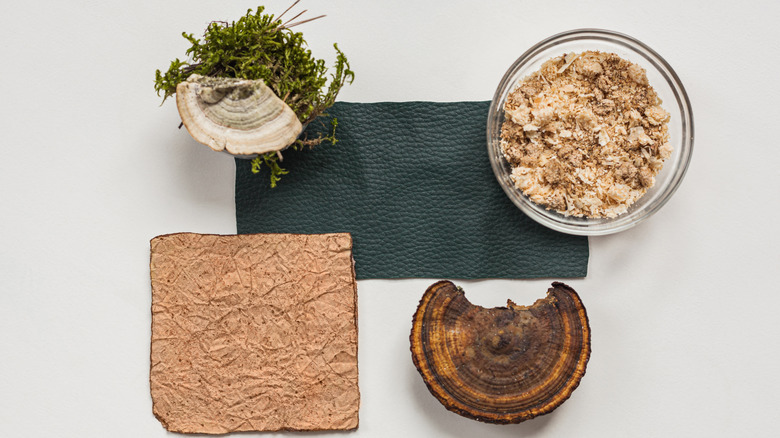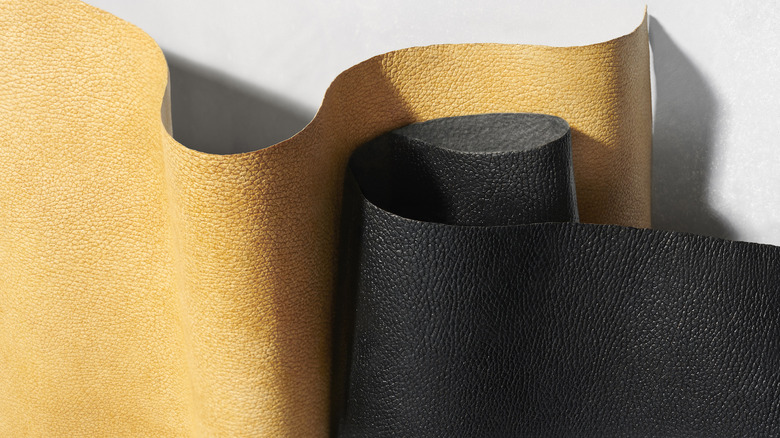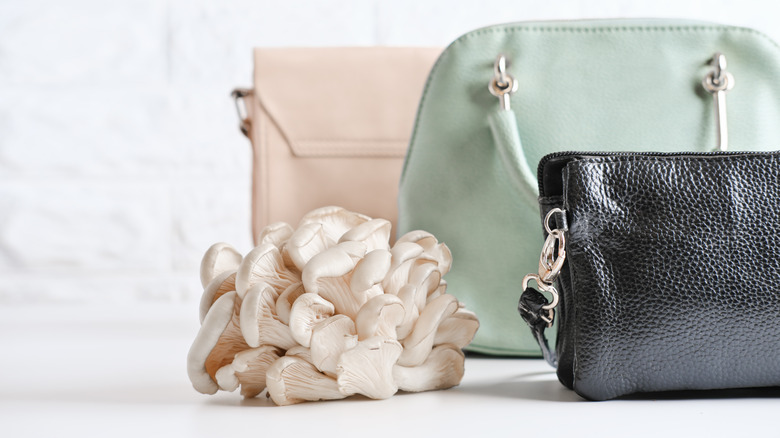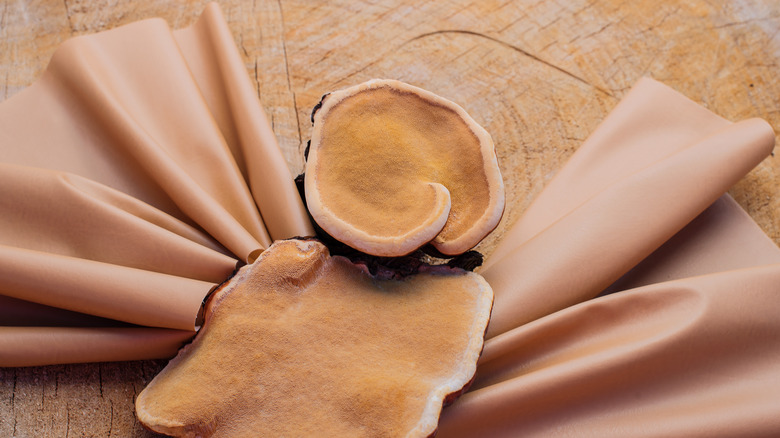What You Need To Know Before Buying Mushroom Leather
You might be most familiar with mushrooms on your dinner plate, but mushrooms are more than a tasty treat. Mushrooms have long been used for their medicinal properties; just a couple of examples according to scientific research include Hippocrates using mushrooms as an anti-inflammatory and indigenous people in North America using puffball mushrooms to treat wounds. Then there are "magic mushrooms" that could treat a range of mental health issues, which are mushrooms containing psilocybin that are being tested for use to treat a range of issues including depression, anxiety, and cluster headaches, via CNN.
And in the last few years, it turns out that mushrooms can be used in even more ways, including in the fashion world. The market for cruelty-free fashion is growing, especially when it comes to finding vegan alternatives for leather. Straits Research valued the world's non-animal leather market in 2021 at more than $31 billion and expects it to reach over $67 billion by 2030. Bio-alternatives to leather include using pineapple leaves, cork, apple, and, yes, mushrooms (via Good on You). Here's some background on the developments in mushroom leather.
Mushroom leather is made from mycelium
The term mushroom leather may make it sound like it's leather made from the mushrooms that we're used to seeing above the ground, but that's not really the case. Mushrooms are a type of fungus, and so they don't have roots the way that plants do. But they do come from a root-like structure called mycelium, per Scientific American. The mushroom that you can see above ground is the fruiting body that gets its nutrients delivered via the microscopic, thread-like fibers called hyphae that make up the mycelium running on top of or beneath the ground.
Mycelium is also used in forests for trees to "talk" to each other. The threads of the mycelium spread in the soil and create a network that connects tree root systems to each other, and trees can send nutrients back and forth to each other via the mycelium, according to Yale Environment 360. Mycelium can grow and create complex multi-molecular structures (via Scientific American). And it's mycelium — that grows quickly and sustainably — that's used to make what's often called mushroom leather.
How and why to make mushroom leather
A number of different companies around the world have started working with mycelium to create a leather replacement. Each one uses its own proprietary process, but basically, they use the fast-growing properties of mycelium to make a material that mimics the feel of leather, according to Scientific American. The mycelium is grown on a substrate, like straw, corn, or sawdust, that gives the mycelium nutrients, and after a few days to a few weeks, it's then compressed — depending on the compression process, different textures and colors can be created (per The VOU). The result is a flexible and lightweight product that mimics "real" leather.
Dan Widmaier, co-founder of Bolt Threads — which makes a mushroom leather material called Mylo — sees the blueprint for their mushroom leather as coming from "all the amazing materials that nature has evolved over the past 3.8 billion years." As for Philip Ross, who co-founded MycoWorks which produces a mushroom leather they call Reishi, he calls mushroom leather "the perfect example of art, science, and advanced manufacturing blending to improve supply chains for fashion and luxury," as The VOU noted.
Mushroom leather is a dupe for real leather
Traditional leather is long-lasting and pretty much always in style, per The Fox Magazine. It's also seen as a luxury good. But with advances in technology, you can get that luxurious feel of high-quality leather with mushroom leather; it "can give the same emotional response as an animal leather. It has that hand-feel of rarity," Matt Scullin — CEO of MycoWorks — told The Guardian.
Bolt Threads co-founder and CEO Dan Widmaier describes their "unleather" as having "a texture remarkably similar to animal-based leather" and it's designed that way to ensure that it "meets brand and customer desires for a soft, supple material reminiscent of traditional leather." This was something that designer Stella McCartney wanted to ensure. "I always say that I don't want anyone to know our products aren't made of leather," she told Vogue, "and it's so important to me that they stand shoulder to shoulder with the real thing."
Mushroom leather compared to other vegan leathers
Being vegan can extend beyond what you eat. Vegan clothing has been a growing trend in recent years, per Fashion United. And many vegan leather options made from plastic polymers come at a lower price point than both real leather and mushroom leather (via Forbes). With increased innovation and adoption, however, the mushroom leather price point is bound to go down, according to The VOU.
Compared to vegan leather made from plastic materials, mushroom leather is the environmentally superior choice. As plastic-based vegan leather is created, it results in a higher risk of microplastics entering the ecosystem (via Popular Science). When mycelium grows, it's carbon neutral, per The Guardian. Plastic-based vegan leather products will take years to biodegrade, and as they do, they can release chemicals into the environment, according to Harper's Bazaar. Mushroom leather, on the other hand, is compostable and biodegradable when you're done with the product, as The VOU points out.
The future of mushroom leather
Bolt Threads based in San Francisco first partnered in 2018 with Stella McCartney to create their signature Falabella bag made from Mylo material, according to Vogue. A few years later, Stella McCartney used their mushroom leather in a bustier and pants set. The company has partnered with other brands, including Lululemon, Adidas, Kering, GANNI, and Tschuyia Kaban to create a range of products, and they're working on a new European production factory. Other companies are working on mushroom leather as well. MycoWorks, for example, has collaborated with Hermès and is planning to build a full-scale manufacturing plant, per Vogue Business. There's also Ecovative, whose Forager division is working to develop and scale mushroom leather for cars and clothes (via Business Wire).
The market for mushroom leather is likely to just keep growing. "Today's consumers care about sustainability and ethical purchasing," Bolt Threads co-founder and CEO Dan Widmaier told The List, "and [they] are demanding the brands they support make choices that align not only with their aesthetic preferences but also with their values."
